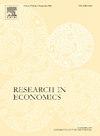Income inequality, poverty, and trade liberalization: Evidence from the Vietnam–Us Bilateral Trade Agreement
IF 1.2
Q3 ECONOMICS
引用次数: 0
Abstract
This study investigates how tariff reductions, introduced by the Vietnam–US Bilateral Trade Agreement (BTA), shaped patterns of income inequality and poverty in Vietnam from 2002 to 2018. Using a province-level dataset derived from the Vietnam Household Living Standards Survey and corresponding tariff measures, the analysis focuses on the P80/P20 ratio for income inequality and the poverty headcount ratio as key outcomes. The findings indicate that while overall poverty rates declined substantially following the BTA, particularly in more industrialized regions such as the Red River Delta and the Southeast, the effects on income inequality were not uniform. In certain areas, notably the Mekong River Delta, reliance on agriculture and limited diversification may have left households vulnerable to global price fluctuations, offsetting the potential gains from enhanced market access. Conversely, regions with robust infrastructure, diverse industrial bases, and higher foreign direct investment witnessed a more pronounced drop in both income inequality and poverty. These results underscore the importance of regional characteristics, including sector composition and connectivity, in determining the distributional consequences of trade liberalization.
收入不平等、贫困与贸易自由化:来自越美双边贸易协定的证据
本研究调查了越南-美国双边贸易协定(BTA)引入的关税削减如何影响2002年至2018年越南收入不平等和贫困的模式。利用越南家庭生活水平调查得出的省级数据集和相应的关税措施,分析重点关注收入不平等的P80/P20比率和贫困人口比率作为关键结果。研究结果表明,虽然总体贫困率在BTA之后大幅下降,特别是在红河三角洲和东南部等工业化程度较高的地区,但对收入不平等的影响并不一致。在某些地区,特别是湄公河三角洲,对农业的依赖和有限的多样化可能使家庭容易受到全球价格波动的影响,抵消了扩大市场准入所带来的潜在收益。相反,在基础设施健全、工业基础多样化、外国直接投资较高的地区,收入不平等和贫困程度的下降更为明显。这些结果强调了区域特征,包括部门构成和连通性,在决定贸易自由化的分配后果方面的重要性。
本文章由计算机程序翻译,如有差异,请以英文原文为准。
求助全文
约1分钟内获得全文
求助全文
来源期刊

Research in Economics
ECONOMICS-
CiteScore
1.40
自引率
0.00%
发文量
37
审稿时长
89 days
期刊介绍:
Established in 1947, Research in Economics is one of the oldest general-interest economics journals in the world and the main one among those based in Italy. The purpose of the journal is to select original theoretical and empirical articles that will have high impact on the debate in the social sciences; since 1947, it has published important research contributions on a wide range of topics. A summary of our editorial policy is this: the editors make a preliminary assessment of whether the results of a paper, if correct, are worth publishing. If so one of the associate editors reviews the paper: from the reviewer we expect to learn if the paper is understandable and coherent and - within reasonable bounds - the results are correct. We believe that long lags in publication and multiple demands for revision simply slow scientific progress. Our goal is to provide you a definitive answer within one month of submission. We give the editors one week to judge the overall contribution and if acceptable send your paper to an associate editor. We expect the associate editor to provide a more detailed evaluation within three weeks so that the editors can make a final decision before the month expires. In the (rare) case of a revision we allow four months and in the case of conditional acceptance we allow two months to submit the final version. In both cases we expect a cover letter explaining how you met the requirements. For conditional acceptance the editors will verify that the requirements were met. In the case of revision the original associate editor will do so. If the revision cannot be at least conditionally accepted it is rejected: there is no second revision.
 求助内容:
求助内容: 应助结果提醒方式:
应助结果提醒方式:


